Monday, December 8, 2014
As we left early this AM for a day visiting well sites (we often use the term “in the field”) the city was a buzz as people were on their way to work. Hawassa is about 5,500 above sea level and our destination was the highlands and over 7,000 feet above sea level.


This photo shares a bit of the terrain – the hut is primarily made of bamboo – using the canes for the bottom and the leaves for the roof. And I never thought there was a good use for bamboo other than a fish pole. The large plants are False Banana (Inset) and the large stalk base is used to make a paste for porridge, for flower (pancake) and mixed with other ingredients like butter. Also saw a few coffee plants as were very near where the Ethiopia Sedama coffee is grown.
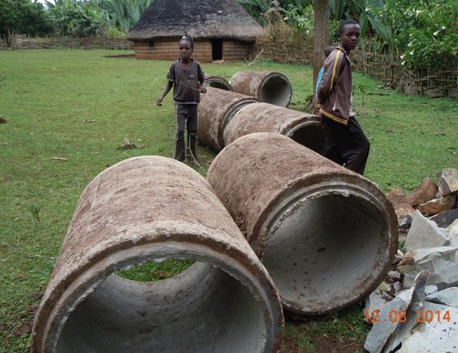
As we arrived at our first well site under construction my focus went to these well casings. Some of our implementing partners pour these on site and DASSC pours at their shop and trucks out to the site whenever feasible.
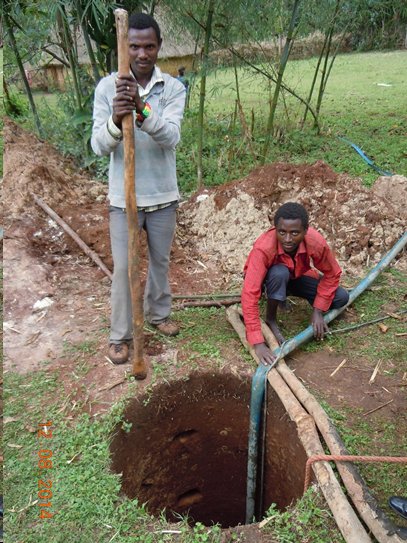
Three notable parts of this dig is noted here. The man in blue has the pack helper when hitting hard dirt he is able to gain some additional pressure. The blue hose tube is connected to a submersible pump powered by a generator via the small cord next to the hose. Note the steps in the side of the hole – there is another set on the opposite side used to go down and up in the hole.
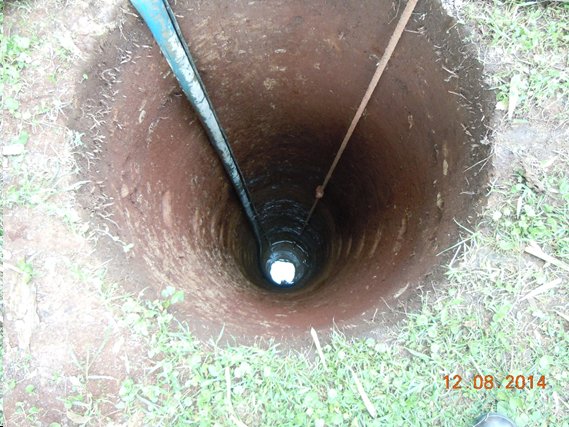
The reflection in the water is my head. The water is at 11 meters (approx. 33 ft) and they are pumping water out so they are able to go to 16 meters (48 ft) so the water will seep in adequately to be a constant course of disease free fresh water.
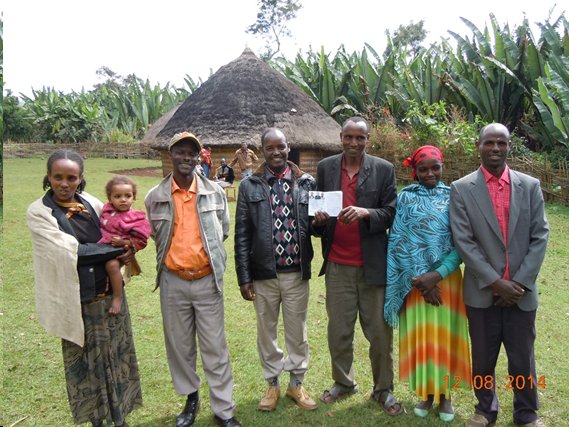
A happy water committee (one lady was not available. The two gentlemen are the committee chair and treasurer. They are holding the passbook and they have collected 1,000 birr ($50.00) for maintenance and other needs. Their current water source is down a steep hill that is often slippery to the stream.
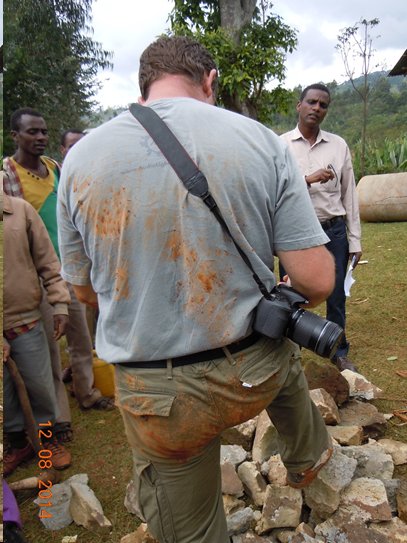
This is one of those embarrassing photos as Michael was moving around taking photos there was this pile of red clay and a good place to take pictures from – well it was slippery and Mike needed to protect the camera so red dirt all over. Now some people have been known to pay for red dirt clothes and while Mike took one for the team he also earned his red dirt clothes. Facing Mike is Tessema Hirbaye of DASSC. He is our main connection with work in this area.
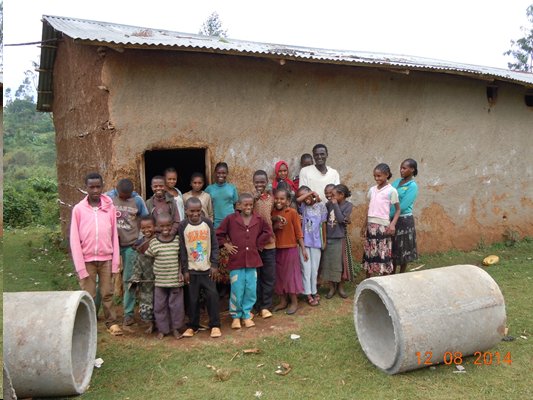
This project is located next to a school (building in background) and one of the teachers is pictured with this group of students.

On to another well in similar construction stage. On the left is the man who was in the hole just a moment ago – note bare feet and the man on the right was the bucket puller. The small bucket and rope are lying there. This one will be a bit deeper to 18 meters or approximately 54 ft.
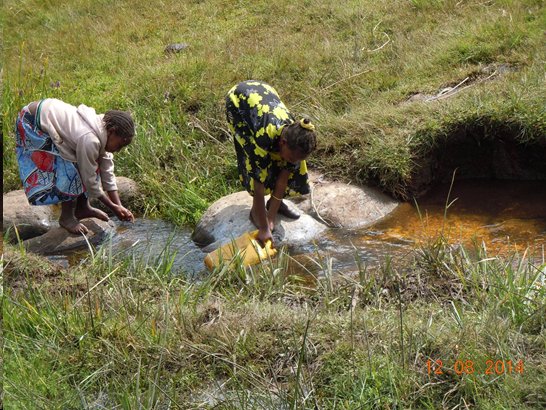
We ended our day by following these sisters fetch some water from the stream. Looks clear doesn’t it however, it is filled with fecal material and below this spot is a moldy area where the water moves slowly. Sisters Batire and Beshuka are 10 and 8 and in the same grade in school. They think they want to be in involved in agriculture. They are looking forward to the well as they expect they will have less diarrhea.
The area we visited has about 165,000 inhabitants and the disease free water coverage is about 27%.
-Ed Scharlau
Monday, December 8, 2014
As we left early this AM for a day visiting well sites (we often use the term “in the field”) the city was a buzz as people were on their way to work. Hawassa is about 5,500 above sea level and our destination was the highlands and over 7,000 feet above sea level.


This photo shares a bit of the terrain – the hut is primarily made of bamboo – using the canes for the bottom and the leaves for the roof. And I never thought there was a good use for bamboo other than a fish pole. The large plants are False Banana (Inset) and the large stalk base is used to make a paste for porridge, for flower (pancake) and mixed with other ingredients like butter. Also saw a few coffee plants as were very near where the Ethiopia Sedama coffee is grown.

As we arrived at our first well site under construction my focus went to these well casings. Some of our implementing partners pour these on site and DASSC pours at their shop and trucks out to the site whenever feasible.

Three notable parts of this dig is noted here. The man in blue has the pack helper when hitting hard dirt he is able to gain some additional pressure. The blue hose tube is connected to a submersible pump powered by a generator via the small cord next to the hose. Note the steps in the side of the hole – there is another set on the opposite side used to go down and up in the hole.

The reflection in the water is my head. The water is at 11 meters (approx. 33 ft) and they are pumping water out so they are able to go to 16 meters (48 ft) so the water will seep in adequately to be a constant course of disease free fresh water.

A happy water committee (one lady was not available. The two gentlemen are the committee chair and treasurer. They are holding the passbook and they have collected 1,000 birr ($50.00) for maintenance and other needs. Their current water source is down a steep hill that is often slippery to the stream.

This is one of those embarrassing photos as Michael was moving around taking photos there was this pile of red clay and a good place to take pictures from – well it was slippery and Mike needed to protect the camera so red dirt all over. Now some people have been known to pay for red dirt clothes and while Mike took one for the team he also earned his red dirt clothes. Facing Mike is Tessema Hirbaye of DASSC. He is our main connection with work in this area.

This project is located next to a school (building in background) and one of the teachers is pictured with this group of students.

On to another well in similar construction stage. On the left is the man who was in the hole just a moment ago – note bare feet and the man on the right was the bucket puller. The small bucket and rope are lying there. This one will be a bit deeper to 18 meters or approximately 54 ft.

We ended our day by following these sisters fetch some water from the stream. Looks clear doesn’t it however, it is filled with fecal material and below this spot is a moldy area where the water moves slowly. Sisters Batire and Beshuka are 10 and 8 and in the same grade in school. They think they want to be in involved in agriculture. They are looking forward to the well as they expect they will have less diarrhea.
The area we visited has about 165,000 inhabitants and the disease free water coverage is about 27%.
-Ed Scharlau

About The Author: Water to Thrive
More posts by Water to Thrive